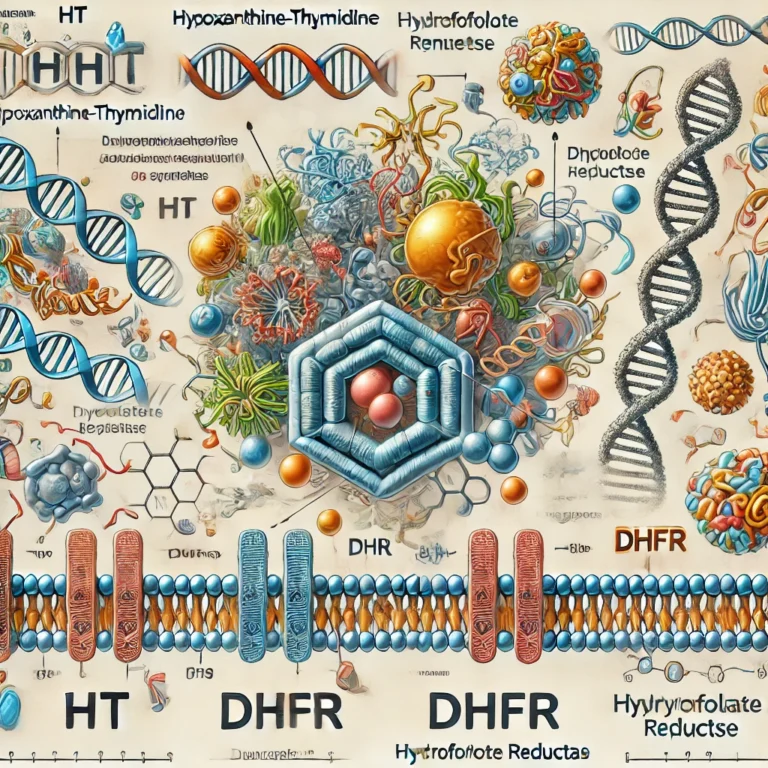what does ht /- dhfr. In biochemistry and molecular biology, certain enzymes play critical roles in fundamental cellular processes. HT (Hypoxanthine-Thymidine) and DHFR (Dihydrofolate Reductase) are two such enzymes essential for nucleic acid metabolism and cellular replication. This article delves into what HT and DHFR are, their biological functions, and why they are significant in medical research, particularly in the fields of cancer and antimicrobial therapy.
1. What is Hypoxanthine-Thymidine (HT)?
Definition and Function of Hypoxanthine-Thymidine
Hypoxanthine-Thymidine, commonly referred to as HT, comprises two purine nucleotides: hypoxanthine and thymidine. Hypoxanthine is a naturally occurring purine derivative found in cells and involved in the synthesis of nucleotides, the building blocks of DNA and RNA. Thymidine is a pyrimidine nucleoside that pairs with adenine to form part of the DNA double helix: what does ht /- dhfr.
HT in Nucleotide Synthesis
HT’s primary role in nucleotide synthesis is crucial, especially in salvaging pathways where cells recycle nucleotides rather than synthesizing them from scratch. This is essential in rapidly dividing cells, such as cancer cells or immune cells, which require a steady supply of nucleotides. The HT-salvage pathway helps to reduce cellular stress by using pre-existing components, ensuring the efficient production of DNA and RNA: what does ht /- dhfr.
HT in Medical Research and Cancer Studies
The HT pathway is frequently studied in cancer research because many cancer cells have an elevated need for nucleotide production. This dependency on HT makes these pathways potential targets for anticancer therapies. By disrupting nucleotide synthesis in rapidly proliferating cells, scientists can limit tumor growth without harming normal cells. Additionally, HT is often used in laboratory settings as a selective marker for genetic engineering in cell culture studies; what does ht /- dhfr.
2. Understanding Dihydrofolate Reductase (DHFR)
The Function of DHFR in Cellular Metabolism
Dihydrofolate Reductase (DHFR) is an enzyme that catalyzes the reduction of dihydrofolate (DHF) to tetrahydrofolate (THF). THF is an essential cofactor in the synthesis of purines, thymidylate, and certain amino acids. This makes DHFR a cornerstone enzyme in cellular processes, as purines and thymidylate are critical for DNA replication and repair; what does ht /- dhfr.
DHFR’s Role in Folate Metabolism
Folate, a B-vitamin essential for DNA synthesis, is converted into its active form, THF, through DHFR. This folate metabolism is particularly important during periods of rapid cell division, such as embryogenesis, immune response, and tissue repair. A deficiency in DHFR activity can lead to impaired DNA synthesis, resulting in anemia, compromised immune function, and developmental defects; what does ht /- dhfr.
DHFR as a Target in Cancer and Antimicrobial Therapy
Due to its role in DNA synthesis, DHFR has been extensively targeted in cancer and antimicrobial treatments. Methotrexate, a well-known chemotherapy drug, inhibits DHFR, blocking the synthesis of DNA and RNA in rapidly dividing cancer cells, which ultimately leads to cell death. Similarly, trimethoprim is an antibiotic that inhibits DHFR in bacteria, providing a selective mechanism to prevent bacterial growth without affecting human DHFR.
3. The HT-DHFR Connection in Genetic Selection
Why Combine HT and DHFR in Biotechnological Applications?
In genetic engineering, HT and DHFR pathways are commonly leveraged together as selectable markers. When scientists introduce new genetic material into cells, they need a reliable way to confirm that the target cells have incorporated the desired gene. DHFR-deficient cells are often used in combination with HT media to select for successfully modified cells. This is known as the HT-DHFR selection system, which provides an efficient and reliable method for producing genetically engineered cells, particularly in mammalian cell lines: what does ht /- dhfr.
Applications in Genetic Research and Medicine
The HT-DHFR system allows researchers to study gene function in a controlled environment, often used in cancer research, regenerative medicine, and pharmaceutical development. By modifying cells to rely on external sources of HT or by using DHFR inhibitors, researchers can control cell survival, enabling precise selection processes that are invaluable in gene therapy research and drug development: what does ht /- dhfr.
4. Clinical Relevance and Therapeutic Implications
Targeting HT and DHFR in Cancer Therapy
Since both HT and DHFR are essential in nucleotide synthesis, they are prime targets in cancer treatment. Inhibitors of DHFR, like methotrexate, have been standard in chemotherapy regimens for various cancers, including breast cancer, leukemia, and lymphoma. Targeting DHFR can lead to cell-cycle arrest and apoptosis (programmed cell death) in rapidly proliferating tumor cells. Additionally, understanding the role of HT pathways can allow researchers to develop combination therapies that reduce resistance to drugs like methotrexate, as cancer cells may develop alternative pathways to bypass DHFR inhibition: what does ht /- dhfr.
HT-DHFR in Antimicrobial Resistance
Bacterial strains with mutations in DHFR can become resistant to antibiotics like trimethoprim. This has driven research into new inhibitors targeting DHFR to combat drug-resistant bacterial strains. The dual approach of understanding both HT and DHFR pathways offers insights into how bacterial cells adapt and survive under antibiotic pressure. Researchers are developing novel DHFR inhibitors that could be effective against resistant strains, thereby enhancing the efficacy of existing antibiotics.
5. Future Directions in HT and DHFR Research
Innovations in Cancer and Antimicrobial Treatments
Continued research into HT and DHFR pathways holds significant promise for future therapies. For example, combination therapies that target multiple points in the nucleotide synthesis pathway may be more effective in overcoming drug resistance in both cancer and infectious diseases. The development of specific DHFR inhibitors for particular bacterial strains could also pave the way for targeted antibiotic treatments with fewer side effects.
Advances in Gene Editing and Synthetic Biology
The HT-DHFR selection system is also expected to play a prominent role in synthetic biology and gene editing. Techniques like CRISPR-Cas9 rely on precise genetic selection, and HT-DHFR markers can facilitate this by ensuring successful gene incorporation. This has broad implications for gene therapy, where accurate selection of modified cells can lead to better outcomes for patients with genetic disorders: what does ht /- dhfr.
Personalized Medicine
As we continue to understand individual differences in DHFR enzyme activity and HT metabolism, personalized medicine approaches become possible. Knowing a patient’s genetic makeup can allow doctors to tailor chemotherapy regimens or antibiotic prescriptions for optimal efficacy, minimizing side effects and improving therapeutic outcomes: what does ht /- dhfr.
By understanding the critical roles of HT and DHFR in cellular metabolism and DNA synthesis, researchers can better develop therapies for a variety of diseases, from cancer to infectious diseases. The continued exploration of these enzymes will lead to advanced treatments and possibly more effective, personalized healthcare solutions.




